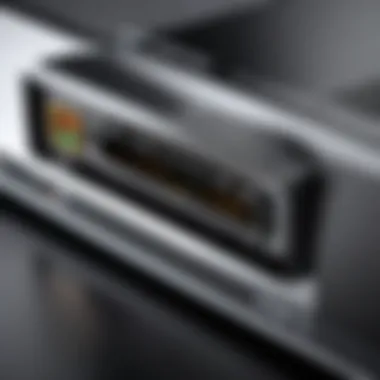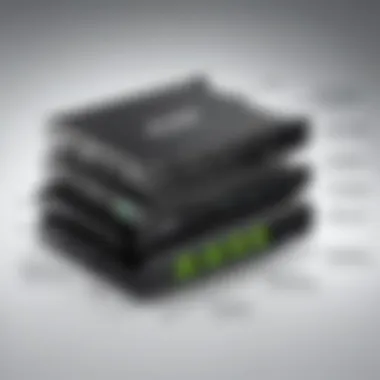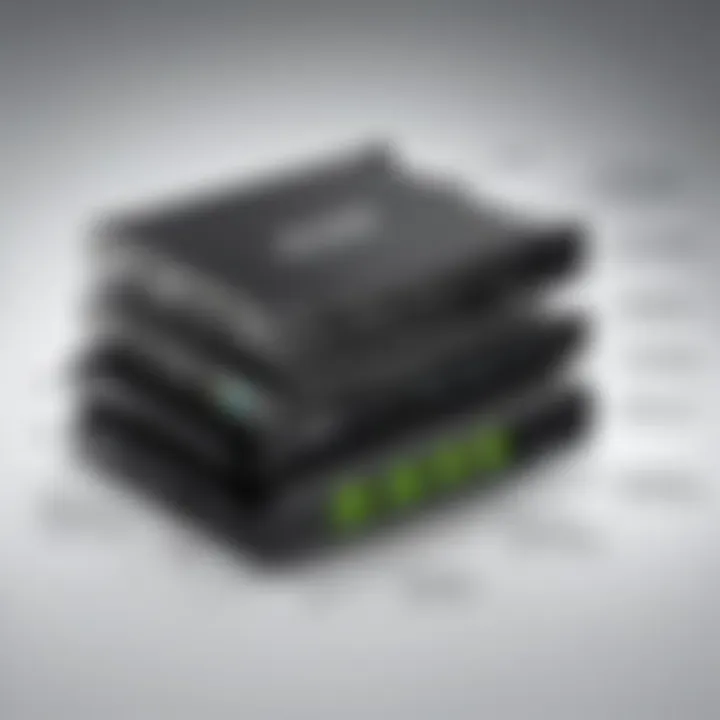Ultimate Guide to Three-Monitor KVM Switches


Intro
As technology evolves, the need for efficient and streamlined workstation setups increases. Three-monitor KVM switches utilizing DisplayPort technology offer significant advantages for IT professionals and tech enthusiasts alike. These switches provide a seamless way to control multiple computers with a single set of peripherals, which improves productivity and enhances the overall user experience.
This guide aims to delve deep into the features, performance, and practical applications of these KVM switches. Understanding their specifications, unique advantages, and real-world scenarios will aid professionals in making knowledgeable decisions for their setups.
Crucial comparisons with other technologies will expand the reader's perspective, ensuring they grasp all aspects before selection.
Features Overview
Key Specifications
Three-monitor KVM switches with DisplayPort come packed with specific features designed to elevate performance and connectivity. Key specifications typically include:
- Support for Multiple Resolutions: These switches can often handle high resolutions like 4K at 60Hz across multiple displays.
- Input/Output Ports: Expect multiple DisplayPort inputs along with USB connections for peripherals.
- Switching Methods: Many switches offer various methods for seamless transitions, such as hotkeys, push buttons, or automatic switching.
- Audio Integration: Some models also support audio switching, allowing sound output through the selected monitor.
Unique Selling Points
The unique aspects of these KVM switches make them stand out among their competitors:
- Ease of Use: Switching between devices is streamlined, reducing the need to constantly rearrange cables.
- Space Saving: Consolidating multiple workstations into one setup reduces clutter and optimizes workspace.
- Enhanced Collaboration: In environments where multiple users need access to a same setup, these devices allow for quick sharing.
- Compatibility: Many three-monitor KVM switches with DisplayPort maintain compatibility with other protocols, providing versatility in various IT environments.
"Three-monitor KVM switches with DisplayPort significantly enhance workflow efficiency by simplifying the management of multiple devices."
Performance Analysis
Benchmarking Results
When evaluating the performance of three-monitor KVM switches, testing often focuses on factors such as:
- Latency: Performance tests usually show minimal latency, ensuring that there is no delay in response when switching between systems.
- Resolution Consistency: Results typically demonstrate stable performance at high resolutions across multiple screens, important for detailed graphical work.
- Peripheral Handling: Benchmarking often reveals efficient handling of attached peripherals without noticeable lag.
Real-world Scenarios
In practical applications, these switches prove highly effective in various settings:
- IT Support Environments: Technicians can address multiple systems quickly, making troubleshooting more efficient.
- Design and Animation Studios: Professionals can manage extensive graphic tasks across three expansive screens, improving their workflow.
- Data Analysis: Analysts can visualize multiple datasets simultaneously, allowing for better decision-making.
This analysis highlights the practical benefits derived from using three-monitor KVM switches equipped with DisplayPort technology, thus presenting an attractive option for professionals aiming to enhance their workstation efficacy.
Preamble to KVM Switches
In today’s complex IT environments, managing multiple systems can be a daunting task. This is where KVM switches come into play. KVM, which stands for Keyboard, Video, and Mouse, is a technology that allows users to control multiple computers using a single keyboard, monitor, and mouse setup. This not only simplifies workspace management but also enhances efficiency, particularly in environments with multiple servers or workstations.
A KVM switch facilitates seamless switching between computers, which is essential for IT professionals who need to monitor and manage various systems simultaneously. By reducing the clutter of peripherals and consolidating control into one interface, KVM switches offer both space and time savings.
Definition and Purpose of KVM Switches
The primary definition of a KVM switch is a device that allows users to control multiple computers through a single set of input devices. The purpose varies across different settings. In data centers, KVM switches enable administrators to manage numerous servers without needing individual keyboards and monitors for each unit. This maximizes the available hardware and minimizes costs associated with buying extra peripherals.
Furthermore, KVM switches are beneficial in environments such as multimedia production and software testing, where users rotate between machines frequently. This flexibility allows for improved productivity, as tasks can be performed without interruption caused by switching connections.
Evolution of KVM Technology
KVM technology has evolved significantly since its inception. Originally, KVM switches were purely analog. These early models required physical connections to each device, making them cumbersome and less efficient. With technological advancements, the introduction of digital KVM switches came around. This version enabled the transmission of signals over longer distances and supported higher resolutions.
Presently, advanced KVM switches incorporate various connection types, including USB and DisplayPort, which is particularly relevant in today's discussion. The shift towards these technologies has improved both performance and user experience. Enhanced compatibility with different types of devices has made KVM switches more versatile, ensuring that they meet the needs of modern IT applications.
In summary, understanding KVM switches is crucial for IT professionals aiming to optimize their environments. As we explore this guide further, we will look closely at the specific functionalities and benefits of three-monitor KVM switches utilizing DisplayPort technology.
Understanding DisplayPort Technology
DisplayPort is a notably significant interface in modern displays and computing environments. Its role in the context of KVM (Keyboard, Video, Mouse) switches is vital, especially when considering setups that utilize multiple monitors. An understanding of DisplayPort technology is crucial for IT professionals who aim to maximize their workspace efficiency. With its advanced capabilities, DisplayPort enables high-resolution displays, enhanced color depth, and greater bandwidth compared to many traditional video outputs.
Overview of DisplayPort Standards


According to recent developments, DisplayPort standards have evolved considerably since its introduction. Currently, DisplayPort 1.4 and DisplayPort 2.0 represent the latest advancements. These versions support up to 8K resolution at 60Hz and even beyond, catering to demanding graphical requirements.
Key features include:
- Multi-Stream Transport (MST) enabling the connection of multiple monitors through a single output.
- Adaptive Sync, which improves refresh rate consistency reducing screen tearing in dynamic applications.
- Audio support, which allows multiple audio channels alongside video, important for multimedia setups.
DisplayPort’s versatility means it supports various resolutions and refresh rates, making it suitable for both professional and personal use.
Benefits of DisplayPort for KVM Switches
Integrating DisplayPort technology into KVM switches brings significant advantages:
- High Resolution and Refresh Rates: Supports advanced resolutions and frame rates for seamless visuals.
- Flexible Connectivity: Ability to daisy-chain multiple monitors simplifies desktop setups.
- Enhanced Data Bandwidth: High bandwidth reduces latency, valuable for real-time applications.
- Seamless Switching: Instantaneous switch capabilities reduce downtime, allowing for efficient workflow management.
"With DisplayPort, KVM switches can utilize the full potential of modern graphics capabilities, catering to the needs of IT administrators, gamers, and digital creatives alike."
The utilization of DisplayPort technology in KVM switches ultimately transforms typical workstations into powerful, multi-functional environments. This aspect is particularly relevant for situations requiring extensive multitasking or intensive graphical applications.
Features of Three-Monitor KVM Switches
The features of three-monitor KVM switches play a crucial role in enhancing productivity and streamlining workflows for IT professionals and tech enthusiasts alike. These devices enable users to manage multiple computers from a single keyboard, video monitor, and mouse setup. In an increasingly complex digital landscape, the ability to seamlessly switch between numerous systems without the clutter associated with multiple peripherals is invaluable.
Multi-Monitor Support
Three-monitor KVM switches boast exceptional multi-monitor support. They allow users to connect three different monitors to a single KVM unit, which is pivotal for tasks that require extensive screen real estate. This is particularly beneficial for data-intensive tasks such as financial analysis, programming, or graphic design. With expanded display capabilities, users can view multiple applications simultaneously, reducing the need to switch between tabs or windows, thereby optimizing overall workflow.
When selecting a KVM switch, it is essential to verify the compatibility with various monitor configurations. Users should ensure the chosen device supports the desired resolutions and refresh rates for their specific monitors. A proper setup not only enhances visibility and clarity but also contributes significantly to maintaining productivity levels during extended work sessions.
Hotkey Switching Capabilities
Hotkey switching capabilities represent another key feature of three-monitor KVM switches. This function allows users to switch between connected computers with simple keyboard shortcuts. The ability to toggle between systems quickly is critical for tasks that demand fast decision-making, such as IT management or software testing.
Implementing hotkey switching increases efficiency since it minimizes time wasted looking for physical buttons or controlling software on the screen. Users often appreciate this feature when conducting presentations or during collaborative work, as it enables swift transitions between different data sets or applications.
Moreover, users should consider customizing hotkeys to further streamline their specific workflows. Familiarity with the switch's hotkey configuration empowers users to set shortcuts that align with their tasks, thus maximizing effectiveness.
Edid Management
EDID management is an important aspect of three-monitor KVM switches. EDID stands for Extended Display Identification Data, which enables monitors and computers to communicate their capabilities effectively. This communication ensures optimal display settings are used when switching between systems.
Effective EDID management means that users will not have to manually adjust display settings every time they switch systems. A well-functioning KVM switch should automatically configure the display according to the connected device’s parameters, such as resolution and refresh rate. This feature alleviates the potential frustration of dealing with incorrect display configurations, allowing users to focus on their work.
Performance Metrics
The performance metrics of three-monitor KVM switches are crucial in determining their effectiveness and suitability for various applications. For IT professionals, understanding these metrics can lead to informed purchasing decisions, ensuring that the selected technology meets both performance requirements and user needs. The aspect of performance in KVM (Keyboard, Video, Mouse) switches directly influences productivity, user experience, and system efficiency.
Resolution and Refresh Rate
Resolution refers to the clarity of the images displayed, measured in pixels. A higher resolution allows for greater detail, which is imperative for professionals dealing with graphic design, video editing, or detailed data analysis. Common resolutions such as 1080p (1920x1080) or 4K (3840x2160) are often supported by advanced KVM switches. Selecting a KVM switch that supports high resolutions and adequate refresh rates can profoundly impact visual quality and the responsiveness of user commands.
Refresh rate denotes the number of times per second the image on the screen is updated, measured in Hertz (Hz). A refresh rate of 60Hz is standard, but for gaming or high-frame-rate videos, a switch supporting 120Hz or higher is preferable. An inadequate refresh rate can result in blurring during fast movements. Thus, investigating both resolution and refresh rate helps to match the KVM switch with the user's specific demands.
Latency and Response Times
Latency measures the delay between input from the user and the corresponding response displayed on the monitor. In high-pressure environments, low latency is critical. Any noticeable lag can hinder performance, particularly in sectors like gaming or real-time simulations. Ideally, a KVM switch should have latency times below a few milliseconds for optimal performance.
Response time, on the other hand, is the time it takes for a pixel to change from one color to another, usually measured in milliseconds as well. Fast response times minimize ghosting effects in fast-moving visuals, ensuring that users experience smooth transitions. When selecting a KVM switch, professionals should prioritize devices that guarantee low latency and quick response times to enhance the overall user experience.
Signal Integrity
Signal integrity is vital in ensuring that the video and audio signals remain clear and undistorted as they are transmitted through the KVM switch. Issues such as signal degradation can lead to pixelation, color distortion, or loss of audio quality, which are detrimental in a multi-monitor setup. To maintain high signal integrity, it is essential that KVM switches are equipped with quality components and support technologies that minimize interference.
Furthermore, the cable used in the connection plays a significant role. Using high-quality DisplayPort cables can prevent issues like crosstalk and ensure that the signals remain robust over longer distances. Monitoring signal integrity helps in maintaining a reliable connection through various setups, leading to a more effective multi-monitor environment.
"Understanding performance metrics such as resolution, refresh rate, latency, and signal integrity can significantly improve the user experience with KVM switches."


Ultimately, examining these performance metrics allows users to choose a KVM switch that not only meets their basic needs but also optimizes their entire workstation configuration.
Key Considerations for Selection
Choosing the right three-monitor KVM switch with DisplayPort can significantly influence your work efficiency and overall user experience. It is essential to evaluate several factors before making a decision. These considerations extend beyond the technical specifications, encompassing how the devices will integrate into your current setup and the types of activities you will undertake.
Hardware Compatibility
The first factor to consider is hardware compatibility. Ensuring that the KVM switch works well with your existing setup avoids unnecessary complications. Different devices have varying requirements regarding operating systems, video outputs, and peripheral connections. An effective KVM switch must support the video resolution and refresh rates of your monitors. For instance, if you are working with 4K displays, not all KVM switches can handle those specifications efficiently. Additionally, check how many ports are available; three-monitor setups need adequate connections for each display.
It's also important to verify compatibility with other connected devices, such as keyboards, mice, and any other peripherals. Some KVM switches come with built-in support for specific hardware brands, while others provide generic support. Make sure to review the specifications provided by manufacturers like IOGEAR or ATEN. Sometimes, firmware updates may enhance compatibility, so always check for the latest updates from the manufacturer’s website.
User Environment and Setup
Your user environment, including the physical workspace and intended usage scenarios, plays a crucial role in selecting the right KVM switch. Consider the layout and space available. If your workstation is particularly tight, space-saving models might be more appropriate.
Moreover, think about the usage scenarios for which the KVM switch will be employed. For IT administration and management, reliability and ease of switching between different systems are paramount. On the other hand, for software development or multimedia production, high resolution, and fast refresh rates could be more critical.
Installation concerns should be addressed as well. Some KVM switches are plug-and-play, while others require manual configuration. For complex setups, it may be necessary to ensure that your team is versed in the installation and configuration processes. Research whether their manuals are easy to understand and if additional support is available. Sessions on forums such as Reddit can be insightful, as fellow professionals often share their experiences and solutions regarding specific models.
"Selecting a KVM switch without considering your environment could lead to suboptimal performance and user dissatisfaction."
By carefully evaluating hardware compatibility and user environment setup, you can make a more informed decision, ultimately leading to a smoother workflow and enhanced productivity.
Comparative Analysis with Other KVM Technologies
When evaluating KVM switches, it is essential to consider different technologies available. Each type has unique strengths and weaknesses that affect performance, usability, and compatibility. The comparison among KVM technologies highlights significant aspects that influence buyer decisions, especially for IT professionals who rely on efficiency. Understanding this landscape helps in selecting the best option that fits specific operational needs.
USB vs DisplayPort KVM Switches
USB KVM switches often offer a basic solution for users needing to manage multiple computers without the complexity of video requirements that arise in multi-monitor setups. They focus primarily on peripheral connectivity, allowing users to switch keyboards, mice, and sometimes audio between devices. However, USB-based switches can struggle with resolution and refresh rates, especially when dealing with high-performance monitors.
In contrast, DisplayPort KVM switches cater specifically to users looking for superior video quality across multiple screens. They typically support higher resolutions, such as 4K at higher refresh rates, which is crucial for graphic design, gaming, or any application requiring detailed visuals. DisplayPort also provides the ability to daisy-chain multiple monitors, streamlining the connection process, and reducing cable clutter.
When it comes to switching latency, DisplayPort KVMs have shown improved response times vs USB alternatives. In fast-paced environments—where synchronization is key—this feature becomes significant to maintain productivity.
Additionally, DisplayPort supports features like Multi-Stream Transport (MST), enhancing the versatility of monitoring setups and allowing diverse configurations.
HDMI vs DisplayPort for Multi-Monitor Setups
HDMI KVM switches have gained popularity, particularly in consumer markets due to their wide usage in televisions and home entertainment systems. They can handle audio along with video, which is beneficial for multimedia applications. However, HDMI technology has certain limitations in multi-monitor configurations, especially when sustained at high resolutions. The bandwidth limit may restrict users from achieving the desired refresh rates when multiple high-resolution monitors are connected.
On the other hand, DisplayPort shines in multi-monitor environments by supporting higher bandwidths compared to HDMI. It facilitates the connection of several monitors through a single output, owing to its unique MST capabilities. Users can create extensive workspaces without cluttering the desk with excess cabling. This configuration is ideal for professionals in fields that require extensive screen real estate, such as software development or video editing.
While HDMI offers ease of use and broad compatibility, DisplayPort KVM switches ultimately provide a more robust solution for discerning users who prioritize high performance and flexibility in their monitor setups. Selecting the appropriate KVM switch technology often depends on specific use cases that dictate performance requirements.
Use Cases for Three-Monitor KVM Switches
Three-monitor KVM switches are invaluable tools in a variety of settings. Understanding the use cases can help IT professionals and tech enthusiasts determine the best applications for their unique setups. The functionality of these switches enhances productivity, simplifies workspace organization, and facilitates efficient management of multiple systems. By leveraging three-monitor KVM switches, users can seamlessly control multiple computers without the clutter and hassle associated with using separate keyboards, mice, and displays.
IT Administration and Management
In IT administration, efficiency is key. With a three-monitor KVM switch, IT administrators can monitor and manage several servers or workstations simultaneously. This is especially useful in data centers where multiple machines are often in operation. The three-screen setup allows administrators to keep track of system performance, view logs, and manage tasks across different computers.
- Centralized Control: Using one keyboard and mouse to control multiple systems leads to less physical strain due to repetitive actions, improving comfort in long sessions.
- Resource Management: Switching instantly between machines means problems can be addressed quickly before they become serious issues, boosting overall resource management workflows.
- Streamlined Operations: The ability to distribute tools and applications across three screens reduces the need for constant window switching, making it easier to follow tasks and track progress.
Gaming and Multimedia Production
For gaming and multimedia production, a three-monitor KVM switch brings multiple advantages. It optimizes the setup for gamers and content creators who require specific configurations.
- Enhanced Visual Experience: Gamers can utilize three screens to widen their field of view, providing a more immersive experience during gameplay. This controls desktops or consoles remotely, benefiting esports players especially.
- Increased Productivity: In multimedia production, professionals can render video, edit graphics, and manage tools simultaneously. Having multiple large displays allows for efficient multitasking, which is essential in meeting tight deadlines.
- Flexible Configuration: The flexibility of switching between different gaming consoles or PCs for different games or tasks enhances the overall experience, allowing users to adapt to various scenarios without hassle.
Software Development and Testing
In the realm of software development, a three-monitor KVM switch can be a game changer. Developers often work on multiple projects concurrently, requiring access to several systems and environments.


- Project Management: Developers can monitor code, documentation, and testing results across three screens, facilitating swift adjustments as needed. This leads to better oversight and project management.
- Testing Environments: With multiple monitors, developers can simultaneously run tests on different environments, increasing efficiency in identifying bugs or issues before they reach production.
- Collaboration Tools: Developers can utilize one screen for coding, another for collaboration tools, and a third for debugging or testing, thus enabling enhanced team cooperation.
"Three-monitor KVM switches offer capabilities that align perfectly with the needs of modern IT professionals, gamers, and developers alike."
In summary, the significant use cases for three-monitor KVM switches span various professional domains, including IT administration, gaming, multimedia production, and software development. These innovations reinforce not only productivity but also facilitate a more organized and integrated workspace. As the demand for multi-system setups grows, the relevance and utility of these switches will only increase.
Setup and Configuration Best Practices
Setting up a three-monitor KVM switch with DisplayPort can seem complex, but following best practices simplifies the process and enhances user experience. Proper setup and configuration maximizes the functionality of the KVM switch, ensuring seamless transitions between multiple systems. Understanding specific steps and considerations can lead to improved performance and stability in any workstation environment.
Physical Setup Procedure
The physical setup of a three-monitor KVM switch involves several critical steps. First, identify the location for your KVM switch. Ensure it is close to the computers and monitors to minimize cable length. Cable management not only improves aesthetics but also reduces interference.
- Connect Monitors: Attach each monitor to the KVM switch using high-quality DisplayPort cables. Confirm that all connections are secure to prevent any display issues.
- Connect Computers: Use DisplayPort cables to connect the computers to the KVM switch. Make sure each computer is connected to the corresponding ports on the KVM switch to facilitate easy switching.
- Power Up Devices: Power on the KVM switch and the connected devices. Some models may require a particular order for powering on to function correctly.
- Adjust Monitor Settings: Once powered on, you may need to adjust display settings on each monitor. Ensure resolution and refresh rates are set appropriately to match your needs.
Following these steps lays a strong foundation for optimal performance and functionality of the KVM switch.
Driver Installation and Software Configuration
After the physical setup is complete, the next phase is to install the necessary drivers and configure the software. This process varies depending on the specific KVM model you are using. Nonetheless, general steps remain consistent.
- Driver Installation: Check the manufacturer’s website for the latest drivers specific to your KVM switch. Download and install these drivers on each connected computer. This step ensures compatibility and enhances performance. Often, these drivers optimize the system's ability to handle multiple displays efficiently.
- Software Configuration: After installing the drivers, it is crucial to set up the software that comes with the KVM switch. This may involve defining hotkeys for easy switching, adjusting display settings, and managing profiles. Review all settings to match your workflow preference.
- Test Configuration: Finally, test the setup. Switch between connected computers to confirm responsiveness and picture quality on all monitors. Address any discrepancies immediately for a smoother operation.
By meticulously adhering to these setup and configuration best practices, users can ensure a fluid experience with their three-monitor KVM switch. Thorough care during setup yields immediate benefits, setting the stage for efficient and effective multitasking.
Potential Challenges and Solutions
The integration of three-monitor KVM switches with DisplayPort technology can greatly enhance workstation efficiency and productivity. However, like any sophisticated technology, they come with potential challenges. Understanding these hurdles is crucial for IT professionals to effectively mitigate issues. This section addresses common problems encountered when using three-monitor KVM switches and offers practical solutions that can streamline the user experience and improve system functionality.
Common Issues Encountered
- Incompatibility with Certain Hardware: One significant issue is the potential incompatibility of the KVM switch with specific devices. Users may encounter problems when connecting older graphics cards or non-DisplayPort devices, which could limit functionality.
- Resolution and Display Issues: Users may experience difficulties regarding display resolution across multiple monitors. This is often due to the limitations of the KVM switch itself or incorrect configurations in the settings. The problem can manifest as blurred images or unsupported resolutions.
- Latency and Performance Bottlenecks: When using KVM switches, some users may notice latency during switching or sluggish performance with high-resolution content. This can stem from insufficient bandwidth or outdated firmware, ultimately hindering the efficiency expected from the setup.
- Hotkey Conflicts: Hotkey switching is often a preferred method for users, but sometimes those hotkeys can conflict with other software hotkeys. This adds further complexity when trying to navigate between different systems.
Troubleshooting Tips
To effectively resolve issues with three-monitor KVM switches, consider the following troubleshooting tips:
- Ensure Hardware Compatibility: Always check the specifications of the KVM switch and ensure it supports the hardware you wish to connect. Investigate any limitations on DisplayPort versions or capabilities of your graphics card before making connections
- Verify Display Settings: Regularly review the display settings on your devices. Ensure that all monitors are configured to their proper resolutions and refresh rates based on the capabilities of the KVM switch.
- Update Firmware: Keep the KVM switch firmware up to date. Compatibility and performance can improve significantly with the latest updates provided by the manufacturer.
- Configure Hotkeys: Check for conflicts in hotkey settings. Adjust or reassign hotkeys in the KVM software interface to avoid overlap with other application shortcuts.
- Test with Different Cables: Using suboptimal cables can affect performance and signal integrity. Consider testing different DisplayPort cables to rule out cable-related issues.
"Compatibility is critical; mismatched technology will lead to frustration."
Future Trends in KVM Technology
The KVM switch market is continually evolving, reflecting advancements in technology and changing user needs. Future trends play a crucial role in shaping how IT professionals and tech enthusiasts approach their workspace. As the demand for multi-monitor setups increases, along with a rise in remote work, understanding these trends is vital for planning future configurations and investments. By staying informed on emerging technologies, users can enhance productivity and efficiency in their operations.
Innovations on the Horizon
Several innovative technologies are on the verge of becoming commonplace in KVM switches. These developments focus on improving functionality, user experience, and compatibility with a variety of devices. Some notable innovations include:
- Enhanced Compatibility: Future KVM switches are expected to support an even wider array of input and output formats. This means seamless integration with various hardware configurations, from different computer brands to diverse operating systems.
- Increased Resolution Support: Higher resolutions such as 8K are becoming more standard. KVM switches will need to evolve to manage higher bandwidths, ensuring clear and sharp images, which is essential for professionals engaged in design and media production.
- Integrated USB-C and Thunderbolt Compatibility: As USB-C and Thunderbolt connectors gain popularity, KVM switches must adapt to these standards. This integration simplifies connections between devices and reduces cable clutter.
- Smart Features and Automation: The future holds potential for KVM switches equipped with smart features. Automation in switching between devices based on user preferences or usage patterns can streamline processes and enhance workflow.
"Future technology trends in KVM switches not only shape devices but also redefine professional workflows."
Predicted Market Developments
The KVM switch market is set for significant shifts. As businesses and individuals adopt more sophisticated IT systems, several developments are anticipated:
- Growth in the Remote Work Sector: The increase in remote working requires more flexible and powerful KVM solutions. Employees working from various locations need efficient setups that can be replicated at home or in shared spaces.
- Rise of AI-Driven Solutions: Artificial intelligence is projected to play a role in KVM management. Smart systems can suggest optimal setups and configurations based on user behavior.
- Emphasis on Cybersecurity: With rising cyber threats, innovations will focus on strengthening security measures within KVM switches. Protection features that prevent unauthorized access will be vital.
- Sustainable Technologies: As awareness of environmental issues grows, more manufacturers will likely prioritize eco-friendly materials and energy-efficient designs for KVM switches.
Culmination
In the realm of multi-monitor setups, three-monitor KVM switches utilizing DisplayPort technology present significant value. This article underscored key elements, such as compatibility, performance capabilities, and practical applications, which IT professionals should consider. The final thoughts on three-monitor KVM solutions encompass their efficiency in managing multiple systems with ease and precision.
Benefits of Implementing a Three-Monitor KVM Switch
First, the enhanced productivity is a major factor. With the ability to switch between different computers seamlessly, professionals can focus on their tasks without the clutter of multiple keyboards and mice. Additionally, high-resolution support and superior refresh rates offered by DisplayPort improve visual quality for tasks ranging from software development to multimedia editing.
Considerations When Selecting a KVM Switch
Critically, users must ensure hardware compatibility, especially between devices. Not all KVM switches support every configuration. Proper understanding of your setup—including resolution requirements and specific tasks—will guide your choice. Furthermore, awareness of common troubleshooting issues can save time and effort down the road.
"Selecting the right KVM switch amplifies operational efficiency in setups where space and performance are paramount."
In terms of future developments, we can anticipate ongoing improvements in technology. Innovations may lead to even more efficient connectivity options and advanced features. As users’ needs evolve, so too must the products available to them.



